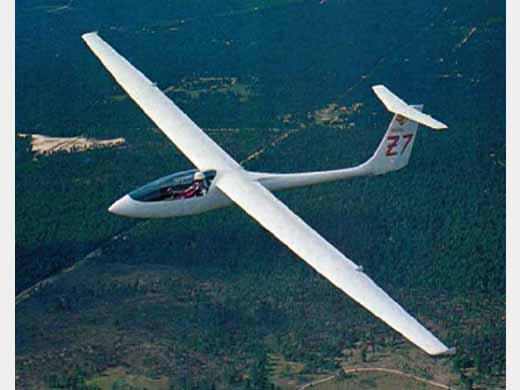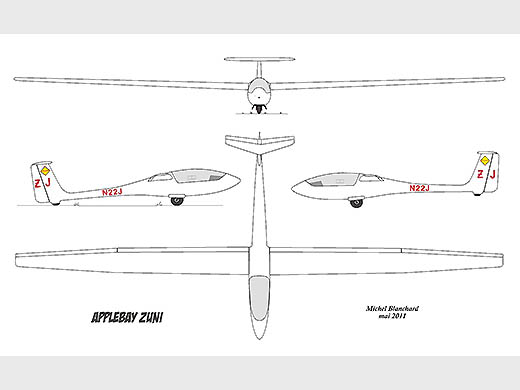
Applebay Zuni
| DONNÉES GÉNÉRALES |
| Année du premier vol (ou de design, si seul projet) |
1976 |
| Pays | USA |
| Designer(s) | APPLEBAY, George |
| Premier constructeur | Aero Tek, Inc. (USA) |
| Type d'appareil | Planeur |
| Fonction | Performance |
| SPÉCIFICATIONS TECHNIQUES |
| Envergure | 15 m |
| Longueur | 6.6 m |
| Hauteur | 1.5 m |
| Allongement | 22 |
| Surface alaire | 10.13 m2 |
| Profil aile | Wortmann FX 67-K-170 à l'emplanture, FX 67-K-150 modifié au saumon |
| Masse à vide | 238 kg |
| Masse maxi | 544 kg |
| Charge alaire | 53.7 kg/m2 |
| Vitesse mini | -- |
| Vitesse maxi | 153 km/h |
| Finesse maxi | 38 à 98 km/h |
| Taux de chute mini | 0.55 m/s |
| Nb sièges | 1 |
| Ballast | 220 L |
| Structure | Tout en fibre de verre. Semelles de longeron en carbone pour le Zuni II |
AUTRES INFORMATIONS
| Constructeur(s) |
| ||||||
| Infos techniques | Les spécifications sont celles du Zuni II. Empennage en T. The aircraft was built using glass-fiber/epoxy resin composite materials, with particular attention to achieving laminar flow. Using the classic pod and boom layout developed by the German glider manufacturers, the Zuni uses a modified Wortmann 67 series airfoil section in a relatively thin double taper wing, (19% at the root to relieve bending moments, rapidly thinning to 15% 0.9m outboard, 14% at the taper intersection and 13% at the tip) which is set high on the fuselage with 1° dihedral, (reducing drag from interference of the wing fuselage junction). The integrally molded fin supports the slightly swept all-moving T-tail, with a small degree of reflex camber and a partially mass-balanced rudder. The single-wheel main undercarriage is manually retractable and a faired tailskid supports the rear fuselage on the ground. Water ballast is carried in integral tanks housed inside the leading edges of the wings, holding 58 gal (484 lb). Conventional control surfaces were fitted, with pitch and roll controlled by a sidestick, and rudder by foot pedals. The entire trailing edge consists of flaps inboard, out to about ⅔ span, with ailerons outboard which also droop when the flaps are deployed. The Zuni II was announced in 1980 and this represented a considerable advance. A center stick replaced the controversial side stick. The new unit was mounted on ball bearings throughout for smooth operation. Wing dihedral was increased to 2° for greater roll stability and better "grooving" in thermals. A new seat pan improved ergonometrics, with higher thigh supports and a flat floor in the rudder pedal area. The pedals were widened to provide a more comfortable angle for the feet. Quick detach mounts on the new pedestal-type instrument panel permit easy removal for access to the forward cockpit. A forward opening canopy opened on parallel linkages. A new flapactuation mechanism provided greater mechanical advantage for deploying the 90° flaps at high speeds. The main gear was repositioned 5" farther aft. The resultant cg change produced a lighter tailwheel loading and easier directional control on rollout. Full-span carbon fiber spar caps became standard on the Zuni II. This allowed weight to be saved with improved strength and stiffness. All-carbon control surfaces (stabilator, rudder, flaps, ailerons) were made available as an option. The factory also directed much effort toward greater precision in wing profiling. New tooling plus improved finishing methods permitted the production of wings with far more accurate leading edges and airfoils than previously possible. Performance was significantly enhanced. A serious attempt was made to minimize free play in the aileron linkage. The system now featured new hookups and closer tolerances throughout. The ailerons are actuated through a 2-to-1 differential system to avoid adverse yaw, and were interconnected to the flaps in the ± 10° range. The integral ballast tanks hold 58 gal of water, bringing the ship to a gross of 1200 lbs at a wing loading of 11 lbs/sq ft. Quality control, production efficiency, and finish were markedly improved. George Applebay and the Zuni II team continued to pursue their dream of producing an American racing sailplane second to none in the world. The Zuni II represented a major step in this direction. The new ship not only outperformed the original Zuni, but it was lighter, stronger, more comfortable, and easier to fly. The flaps and ailerons may be operated separately or interconnected. Although the wing is unusually thin it provides space for up to 181 kg of water ballast. The modèle II model has carbon spar caps and optional carbon control surfaces, and water ballast capacity is increased to 219 kg. | ||||||
| Histoire résumée | The Applebay Zuni, and the later refined Applebay Zuni II, were intended to compete with European fiberglass gliders that have dominated 15m class competitions since the class was established. The aircraft is named for the Zuni people. Flight testing commenced in November 1976 with excellent results which generated much interest from the American gliding community and encouraged Aero Tek to start production. Billy Hill flew his Zuni to wins in the 1977 and 1979 Region 9 contests and won the longest task (352 miles) at the 1977 Nationals. These competition successes quickly showed that the Zuni was at least the equal of European built contenders, and were reinforced by a favorable report in Soaring magazine by George Moffat. But the early success was marred by a fatal accident in May 1977, caused by structural failure. Aero Tek was forced out of business in 1978 but George was determined to continue development of the Zuni. He formed a new company, Applebay Sailplanes, with daughter Georgann as its president, and they bought the tooling and assets from Aero Tek. Dick Johnson performed a Flight Test Evaluation of the Zuni in 1979 and found weaknesses in the design. George took these to heart and embarked on a complete rework of nearly every aspect of the design. Three Zuni II aircraft were leased by the Polish gliding team to represent Poland in the 1983 World Gliding Championship. Modest success in National competitions was repeated in world class competition, but legal issues over an early structural failure and the low level of investment prevented the Zuni from achieving its full potential. The poor currency exchange rates of the early 1980s allowed European gliders to be imported at lower prices than equivalent American goods. Jerry G. Mercer donated his Zuni II to the Smithsonian Air and Space Museum in 1982, after acquiring all of his Silver C, Gold, and two Diamond FAI gliding badges during one flight over Taos, New Mexico, an accomplishment that had never been done before. FAI soaring badges were earned in the Zuni, Billy Hill and Doug Barritt flew a number of New Mexico and Nevada State and National records in the Zuni in the 1980s. The Zunis are still out there, flying. Steve Leonard has set Kansas and New Mexico state records and won a number of contests in his Zuni II, including a first place in the 2009 Region 10 South Sports Class contest at Brenham, TX. A total production of 20 Zuni and Zuni II aircraft had been built when production terminated in 1983. As of March 2015, 14 Zunis continue to be listed on the US Federal Aviation Administration aircraft registry. | ||||||
| Liens personnalités | APPLEBAY, George (USA) | ||||||
| Exemplaires existants |
| ||||||
| Compléments docs |
SOURCES DOCUMENTAIRES
| Liens WEB | Site : Alex Sailplane Directory . Note + 1 photo + specs. (2009-11-06 CL) Site : Southwest Soaring Museum . Texte + photo + specs. (2015-05-28 CL) Site : National Air and Space Museum . Zuni II N2ZJ. Texte + photo. (2015-06-04 CL) Site : Aviation History . Texte + photo. (2015-06-04 CL) Site : Southwest Soaring Museum . Newsletter 2016 n° 1c. Texte + photo. (2018-05-06 CL) |
| Livres | Sailplanes 1965-2000 par SIMONS, Martin (2005) [p. 229. ]. |

Team J2mcL © 2003 -
- Pages optimisées pour Mozilla Firefox


